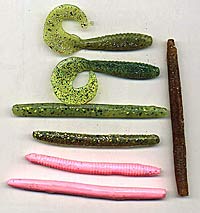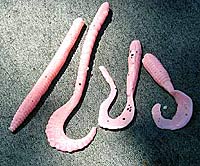
 If you're serious about pouring your own plastics, then you need the right materials for the best results. The following is
a guide to help you decide which is right for your needs.
If you're serious about pouring your own plastics, then you need the right materials for the best results. The following is
a guide to help you decide which is right for your needs.
Plastisol
Other than reusing old lures to make
new lures, plastisol is the basic liquid used by all soft plastic, lure producers. Plastisol looks like milk, feels like oil
and turns crystal clear when heated to around 300 degree F.
 Good quality plastisol has these characteristics:
Good quality plastisol has these characteristics:
- Easy to mix in its storage container
- Consistent in hardness between batches
- Stable at high temperatures - color stability and clarity
- Does not smoke or smell when heated
- Holds up to reheating without searing or discoloring.
The three grades are soft, medium and saltwater firm
Two companies that sell good plastisol are M-F manufacturing and www.Lurecraft.com. Ozark plastic is next in quality though a few think it too soft.
In my opinion Calhoun's plastic, is the least consistent when it comes to quality and should be avoided!
Dye
White dye is necessary for bright opaque, florescent colors such as bubblegum or florescent lime, orange
or chartreuse. Florescent colors are brighter in deeper water, without hue change. Most dyes will produce translucent colored
plastic when held up to the sky or against a light, sandy bottom. Dyes can be mixed for desired colors. Tackleunderground
has many contributed recipes for special effects.
 Again, quality varies as does price, variety and color accuracy. Lurecraft has variety, but opinions vary concerning color
accuracy. Purple is blue-grape, motor oil is blackish brown, bubblegum is salmon, etc. Del-Mart has started providing dye
and so far, I'm pleased with price and quality.
Again, quality varies as does price, variety and color accuracy. Lurecraft has variety, but opinions vary concerning color
accuracy. Purple is blue-grape, motor oil is blackish brown, bubblegum is salmon, etc. Del-Mart has started providing dye
and so far, I'm pleased with price and quality.
Glitter
Glitter can be used in place of dye and still provide
very good coloration to clear or smoke-colored plastic, just by internally reflected glitter color.
Note: Craft glitter
is usually not suitable for use in hot plastic. Flake-folding and shrinkage and color fade/bleed are big problems. Metalized
craft glitter will catch on fire when used in a microwave and burn plastic.
Polyacetate flakes are not metal coated, stay bright and hold their shape and color past 300 degrees. They come
in square and hexagonal shapes depending on the supplier. Only violet or purple bleed slightly, whereas most other colors
stay true.
Sizes:
- .008 - superfine
- .015 - medium fine - used for smaller lures or in larger lures with .040
- .025, .035, .040 - used for larger lures
- .063, .090 - jumbo glitter used for textured or scale appearances

 Molds
Molds
One part molds are adequate for many lure designs, but totally inadequate for others. The more detailed and
complex the design, the less adequate a one-part mold will be.
 Pre-made silicone molds can be found at Lurecraft.com, but all produce flat sided baits. Del-Mart and Bob's Tackle Shack offer laser cut aluminum molds in one or two parts. The results are professional and may justify the large cost above
$10 silicone molds.
Pre-made silicone molds can be found at Lurecraft.com, but all produce flat sided baits. Del-Mart and Bob's Tackle Shack offer laser cut aluminum molds in one or two parts. The results are professional and may justify the large cost above
$10 silicone molds.
Plaster molds are the cheapest alternative that you can easily make yourself and cost pennies. Other
material are silicone, resin and fiberglass but are at a greater cost and have fumes. (If interested in making your
own, see my page on mold making.)

Worm Oil
Worm oil is used to grease up a plastic lure, keep it from drying out, maintaining its softness, adding
scent (if desired), used as a worm release agent for heavily textured designs, and to provide a super shiny surface.
 Mineral oil, baby oil, Baitmate®, Original FishFormula®, Kick-N-Bass®, Mega Strike®, garlic PAM® spray and a bunch of others,
do the above.
Mineral oil, baby oil, Baitmate®, Original FishFormula®, Kick-N-Bass®, Mega Strike®, garlic PAM® spray and a bunch of others,
do the above.
Heating and pouring equipment
Microwaves sell for about $39, Pyrex® cups for under $8. Small metal pans for
stovetop heating are also cheap and fairly easy to clean.
A Lee Production Pot for soft plastics is around $55, but has it's limitations as far as ease of use and
cleaning. Lures requiring no additives (salt, large flake glitter), do fine and the internal thermostat will keep the plastic
at a stable temperature.
Note: The softer the plastic, the harder it is to clean from a metal or glass container.
Salt and bubbles
 Plastic lures that have don't have salt added, are more buoyant. A Texas-rigged worm will stand 45 degrees off bottom;
lures fall slower when used with lighter hooksl; a Carolina-rigged plastic will stay off the bottom much better than a salted
worm.
Plastic lures that have don't have salt added, are more buoyant. A Texas-rigged worm will stand 45 degrees off bottom;
lures fall slower when used with lighter hooksl; a Carolina-rigged plastic will stay off the bottom much better than a salted
worm.
Microbubbles can be added to float a lure, with the hook embedded, whereas salt is added for increased
weight and texture. Salted plastic allow longer casting distances, but are less durable because of the amount of softener
needed to maintain softness and finesse actions.
Fine salt is necessary for hand pouring, whereas manufacturers use an automated process that swirls crystal salt
into a heat injected mold. I turn table salt into a fine flour, which stays suspended throughout the molten plastisol.
A $15 electric spice or coffee grinder will do.
Bubbles add super floatation and are sold by most handpour suppliers .

